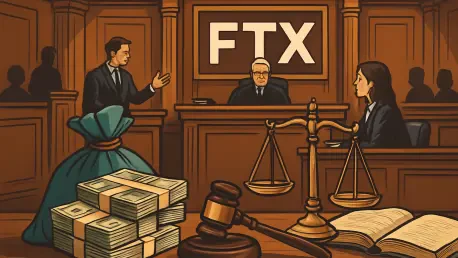Diving into the complex world of cryptocurrency and financial recovery, I’m thrilled to sit down with Priya Jaiswal, a renowned expert in banking, business, and finance. With her deep knowledge of market analysis, portfolio management, and international business trends, Priya offers unparalleled insight into the high-stakes drama surrounding the FTX Recovery Trust’s $1.15 billion lawsuit against Genesis Digital Assets. Today, we’ll explore the intricacies of this case, from reckless investments and mismanagement to the broader implications for creditors and the crypto industry.
Can you walk us through the core reasons behind FTX Recovery Trust’s $1.15 billion lawsuit against Genesis Digital Assets?
Certainly, Eva. The FTX Recovery Trust is targeting Genesis Digital Assets to recover funds from what they’ve described as one of the most reckless investments made by Sam Bankman-Fried, the former CEO of FTX. Between October 2021 and April 2022, he poured $1.15 billion into this Kazakhstan-based crypto mining company through Alameda Research, an FTX subsidiary. The lawsuit claims this investment was based on misleading information and ignored glaring warning signs. The ultimate goal here is to claw back these funds to help repay FTX creditors who’ve been locked out of their money since the exchange’s collapse.
What made this investment in Genesis Digital Assets seem so risky and ill-advised at the time?
The investment was deemed reckless due to several alarming factors. For starters, Bankman-Fried relied on unaudited financial statements from Genesis Digital Assets that, according to the lawsuit, didn’t reflect reality. On top of that, there were clear red flags during the due diligence process, like skyrocketing energy costs and a lack of interest from other investors. Yet, he went ahead with an inflated valuation that even a board member reportedly called “insane.” It’s a classic case of ignoring critical data for a high-stakes gamble.
How did Kazakhstan’s energy crisis play a role in the challenges faced by crypto mining operations like Genesis Digital Assets?
Kazakhstan became a hotspot for crypto miners in 2021, but this influx overwhelmed the country’s electrical grid, leading to a full-blown energy crisis. The government had to impose strict caps on energy usage for miners to prevent further strain. This created a tough environment for companies like Genesis Digital Assets, which struggled to operate sustainably. The lawsuit suggests that these power constraints forced the company to seek additional funds to relocate operations to the U.S., a move that Bankman-Fried funded despite knowing the underlying issues.
The lawsuit highlights that over half of the investment funds went directly to the co-founders of Genesis Digital Assets. What’s your perspective on how this impacted the company?
It’s a significant concern when such a large portion of investment capital—meant to grow the business—ends up in the personal pockets of co-founders. According to the lawsuit, over half of the $1.15 billion went straight to Rashit Makhat and Marco Krohn, allowing them to cash out while the company itself saw little to no benefit. This kind of payout can cripple a firm’s ability to invest in operations, infrastructure, or innovation, especially for a mining company already grappling with external challenges like energy restrictions. It raises serious questions about governance and priorities.
There’s mention of ‘looted funds’ from Alameda Research being used for this investment. Can you explain what that means and its broader implications?
The term ‘looted funds’ refers to the allegation that Bankman-Fried used money from Alameda Research—funds that weren’t rightfully his to spend—for this investment. Essentially, it’s claimed he misappropriated customer deposits or other resources to fuel risky bets like the one on Genesis Digital Assets. This kind of financial juggling contributed heavily to FTX’s liquidity crisis and eventual bankruptcy. It paints a picture of gross mismanagement and a lack of separation between FTX and Alameda, ultimately eroding trust and leading to massive losses for creditors.
With FTX Recovery Trust already disbursing billions to creditors, how does this lawsuit fit into their broader repayment strategy?
The Trust has made significant progress, paying out around $6 billion to creditors earlier this year and planning another $1.6 billion soon. This lawsuit against Genesis Digital Assets is part of a larger effort to recover every possible dollar from questionable investments made under Bankman-Fried’s leadership. By targeting these transactions, the Trust aims to maximize returns for those who lost money in FTX’s collapse. However, recovering funds from international entities like this one, now based in Dubai, comes with legal and logistical hurdles, and there’s no guarantee they’ll recoup the full $1.15 billion.
Looking ahead, what is your forecast for the recovery efforts in the crypto space following high-profile collapses like FTX?
I think we’re entering a phase of heightened scrutiny and legal battles in the crypto industry. Recovery efforts will likely become more aggressive as trusts and liquidators chase down assets across borders, especially with cases as massive as FTX. We’ll see tighter regulations emerge to prevent similar mismanagement, but the road to full recovery for creditors will be long and uncertain. The volatility of digital assets, combined with jurisdictional challenges, means not everyone will be made whole. Still, these lawsuits set important precedents for accountability, and I expect more innovative strategies to track and reclaim funds in the years ahead.









